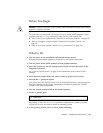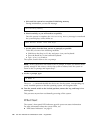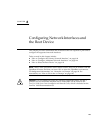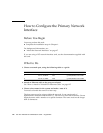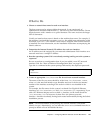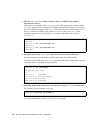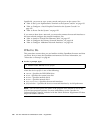
Chapter 8 Configuring Network Interfaces and the Boot Device 147
What to Do
1. Choose a network host name for each new interface.
The host name must be unique within the network. It can consist only of
alphanumeric characters and the dash (-). Do not use a dot in the host name. Do not
begin the name with a number or a special character. The name must not be longer
than 30 characters.
Usually an interface host name is based on the machine host name. For example, if
the machine is assigned the host name sunrise, the added network interface could
be named sunrise-1. The machine’s host name is assigned when Solaris software
is installed. For more information, see the installation instructions accompanying the
Solaris software.
2. Determine the Internet Protocol (IP) address for each new interface.
An IP address must be assigned by your network administrator. Each interface on a
network must have a unique IP address.
3. Boot the operating system (if it is not already running) and log on to the system as
superuser.
Be sure to perform a reconfiguration boot if you just added a new PCI network
interface card. See “How to Initiate a Reconfiguration Boot” on page 138.
Type the su command at the system prompt, followed by the superuser password:
4. Create an appropriate /etc/hostname file for each new network interface.
The name of the file you create should be of the form /etc/hostname.cenum,
where ce is the network interface type identifier and num is the device instance
number of the interface according to the order in which it was installed in the
system.
For example, the file names for the system’s on-board Sun GigaSwift Ethernet
interfaces are /etc/hostname.ce0 and /etc/hostname.ce1, respectively. If you
add a PCI Ethernet adapter card as a third ce interface, its file name should be
/etc/hostname.ce2. At least one of these files—the primary network
interface—should exist already, having been created automatically during the Solaris
installation process.
Note – The documentation accompanying the network interface card should
identify its type. Alternatively, you can enter the show-devs command from the ok
prompt to obtain a list of all installed devices.
% su
Password:



